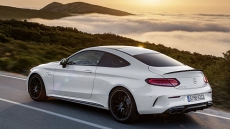Powerful and efficient
Infiniti has created a luxury sports sedan formula in the facelifted 2019 Q50 not easy to replicate: Japanese-inspired styling that is beautiful yet flies under the radar; a smooth, relatively small displacement twin turbo engine that is powerful but efficient; and a well appointed, connected cabin that is premium and high-tech without being overly complicated.The automaker recently introduced new nomenclature for the range: a base LUXE grade, SPORT, which DARPAN was loaned as test model, and the top-of-the-line RED SPORT.

One of the significantly reworked areas of the exterior is the brand’s signature double-arch grille. The woven mesh in the middle is tighter and the chrome surround tweaked to give a greater three-dimensional quality. The SPORT and RED SPORT’s front bumper shape has been chiselled, and the outer air intakes are wider and pushed lower creating a further aggressive appearance. Integrated corner splitters finish off the package.
The rear of the vehicle also receives special treatment hinting at the performance lying underneath. The diffuser surrounding the twin exhaust pipes is now a dark metallic colour, and the taillights are combination halogen/LED and are slimmer in shape taking a cue from the Q60 coupe.

While the Q50 looks long and lean on the outside, it is still classified as a compact. I didn’t feel tight for space behind the wheel, but one of my passengers in the back was surprised there wasn’t more excess legroom than the available 892 millimetres given the perceived bigger footprint. The interior does seem a bit classier, and designers have done a good job marrying technology with nature-inspired themes.
Infiniti’s InTouch infotainment system is the command centre for everything from programming individual personalized seat positions to choosing a SiriusXM Satellite Radio channel. Inputs are accepted via two screens: an eight-inch unit above – handling frequently used functions like navigation – and a seven inch below. The two displays open up extra real estate compared to a conventional single-monitor, and allows easier access to apps and such, so users don’t have to furiously swipe through different pages to locate what they want. Climate settings however are still buried fairly deep in submenus, requiring a few taps to get to.

Occupants will be pleased to hear the Q50 possesses the brand’s “zero gravity” seats, built to provide a high level of support and reduce pressure on the entire back. The driver’s seat and dashboard were engineered together so that the person operating the vehicle doesn’t need to change his or her posture to manipulate any switches or touch panels. The cabin in general exudes a pleasant aesthetic, featuring plenty of soft-touch materials and specially curated wood trim treated to retain its original grain. The SPORT grade utilizes a 3.0-litre twin-turbocharged V6 engine mated to a seven-speed automatic transmission. It’s the same powertrain as found in the 400-horsepower RED SPORT variant, although detuned a tad to output 300 horses instead. Power delivery is smooth and consistent – there’s a hint of turbo lag, and the car gets moving quite nicely once the RPMS begin to climb. The motor is whisper quiet, a benefit for most except for those that prefer a little growl to go with their acceleration.

Steering and suspension are both digital. The former is called Direct Adaptive Steering and actually does a good job offering a mechanical feel, at the same time yielding the benefits of an electronic setup such as autonomously adjusting the ratio and effort according to the current situation (think parking). Fully customizable, the amount of assistance and feedback can be changed on the fly. The latter has the ability to constantly adjust shock damping during cornering to maintain a flat ride throughout and, like DAS, may be tailored according to driver preference.

HIGHLIGHTS
MSRP: $47,245
Motor: 3.0-litre twin-turbocharged V6
Horsepower: 300 @ 6,400 rpm
Torque (lb-ft): 295 @ 1,500 rpm
Gearbox: Seven-speed automatic
Layout: Front engine, all-wheel drive
Fuel economy: 10.1 L/100 km mixed city/highway (observed)
